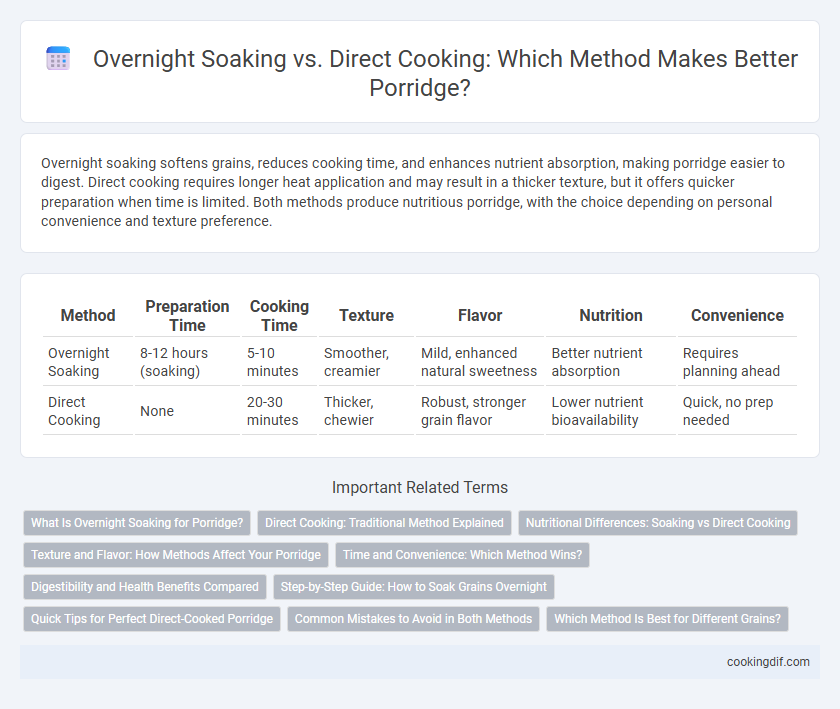Overnight soaking softens grains, reduces cooking time, and enhances nutrient absorption, making porridge easier to digest. Direct cooking requires longer heat application and may result in a thicker texture, but it offers quicker preparation when time is limited. Both methods produce nutritious porridge, with the choice depending on personal convenience and texture preference.
Table of Comparison
| Method | Preparation Time | Cooking Time | Texture | Flavor | Nutrition | Convenience |
|---|---|---|---|---|---|---|
| Overnight Soaking | 8-12 hours (soaking) | 5-10 minutes | Smoother, creamier | Mild, enhanced natural sweetness | Better nutrient absorption | Requires planning ahead |
| Direct Cooking | None | 20-30 minutes | Thicker, chewier | Robust, stronger grain flavor | Lower nutrient bioavailability | Quick, no prep needed |
What Is Overnight Soaking for Porridge?
Overnight soaking for porridge involves immersing grains or oats in water or milk for several hours or overnight, allowing them to absorb liquid and soften naturally before cooking. This process reduces cooking time, enhances nutrient absorption, and improves digestibility by breaking down phytic acid and other antinutrients. Compared to direct cooking, overnight soaking results in creamier texture and richer flavor, making it a popular method for preparing nutritious porridge.
Direct Cooking: Traditional Method Explained
Direct cooking of porridge involves boiling grains directly in water or milk without pre-soaking, preserving the natural texture and flavor of cereals like oats, rice, or millet. This traditional method not only saves preparation time but also enhances nutrient retention by minimizing nutrient loss that can occur during soaking. Common in many cultures, direct cooking delivers a hearty, consistent porridge that is rich in fiber, vitamins, and minerals, making it a wholesome breakfast option.
Nutritional Differences: Soaking vs Direct Cooking
Overnight soaking of grains before cooking porridge enhances nutrient absorption by reducing phytic acid, an antinutrient that binds minerals like iron, zinc, and calcium, making them more bioavailable. Direct cooking retains more water-soluble vitamins such as B-complex but may leave higher levels of antinutrients, potentially hindering mineral uptake. Selecting soaking or direct cooking methods influences the porridge's nutritional profile, impacting overall mineral bioavailability and vitamin retention.
Texture and Flavor: How Methods Affect Your Porridge
Overnight soaking softens grains, leading to a creamier texture and enhanced natural sweetness in porridge by breaking down starches before cooking. Direct cooking yields a firmer texture with a more robust, nutty flavor as the grains cook more quickly without pre-soaking. Choosing between these methods significantly impacts the porridge's mouthfeel and depth of flavor.
Time and Convenience: Which Method Wins?
Overnight soaking significantly reduces morning cooking time, allowing porridge to be prepared quickly with minimal effort. Direct cooking requires longer active cooking time, often 20-30 minutes, demanding more attention during preparation. For busy schedules, overnight soaking offers superior convenience by enabling a ready-to-cook base that streamlines meal preparation without sacrificing texture or flavor.
Digestibility and Health Benefits Compared
Overnight soaking of grains enhances porridge digestibility by breaking down phytic acid and activating enzymes, which improves nutrient absorption and reduces gastrointestinal discomfort. Direct cooking preserves more antinutrients, potentially hindering mineral uptake and causing slower digestion. Choosing overnight soaking supports better gut health and maximizes vitamins and minerals available in porridge.
Step-by-Step Guide: How to Soak Grains Overnight
Soaking grains overnight for porridge softens the kernels, reducing cooking time and enhancing nutrient absorption. Begin by rinsing the grains thoroughly, then submerge them in water at room temperature for 8 to 12 hours. Drain and rinse the soaked grains before cooking to ensure a smoother texture and improved digestibility.
Quick Tips for Perfect Direct-Cooked Porridge
For perfect direct-cooked porridge, use a 1:4 ratio of oats to water and stir continuously to prevent clumping and ensure even cooking. Choose rolled oats for faster cooking times, typically around 5 minutes, while steel-cut oats require longer simmering. Adding a pinch of salt early enhances flavor, and finishing with a splash of milk or cream creates a creamy texture.
Common Mistakes to Avoid in Both Methods
Soaking porridge grains overnight can lead to bacterial growth if left too long or stored improperly, while direct cooking often results in uneven texture due to insufficient soaking. Avoid using water that is too hot for soaking, as it can degrade nutrients, and never skip rinsing grains before cooking to remove impurities and excess starch. Both methods require careful timing to prevent overcooking or undercooking, ensuring a smooth, creamy porridge consistency.
Which Method Is Best for Different Grains?
Overnight soaking softens grains like steel-cut oats and barley, reducing cooking time and improving digestibility, making it ideal for tougher grains. Direct cooking suits quick-cooking grains such as rolled oats or quick millet, delivering faster preparation with a creamy texture. Selecting the best method depends on the grain's hardness and desired porridge consistency.
Overnight soaking vs Direct cooking for porridge Infographic

 cookingdif.com
cookingdif.com